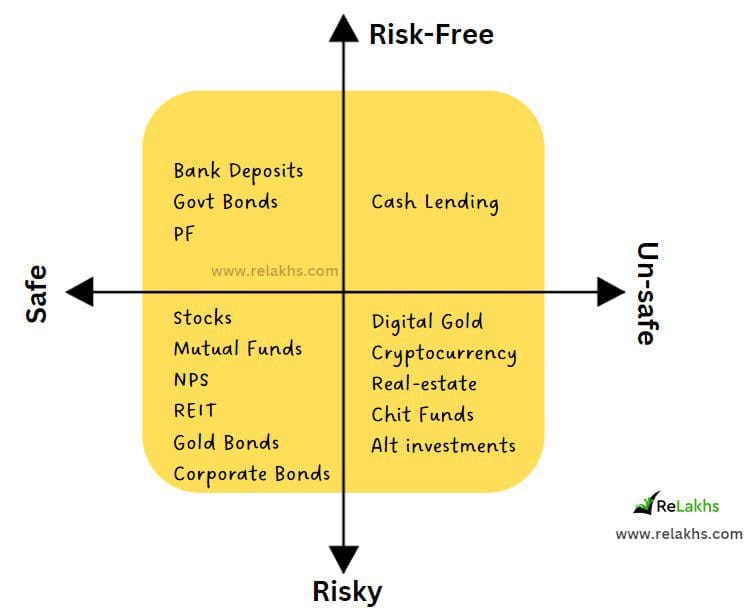Why should I take risk and invest my hard-earned money? To achieve my financial goals, do I need to take risk? Does fortune favor the brave? – Questions which you have undoubtedly asked yourself many times!
In Hindu mythology, the saying goes as ‘Dhairye Sahase Lakshmi‘, it means that courage and valor itself is Lakshmi (the goddess of wealth). You may have a good savings rate but that does not necessarily fetch you decent investment returns and make you wealthy.
The biggest difference between saving and investing is the level of risk taken. Saving typically results in you earning a lower return but with virtually no risk. In contrast, investing allows you the opportunity to earn a higher return, but you take on the risk of loss in order to do so.
So, do you need to go all out and invest in “risky and un-safe” investment options? The answer is a big NO!
In an era where you are “required” to invest to achieve your financial goals, minimizing risk and finding safe investment opportunities has become a necessity.
Risk-free and safe, are they one and the same? Can risk-free investment be an un-safe investment option? My perspective on risk and safety..
What is Risk?
A risky investment is one whose value can go up or drop more often and is greater in magnitude than a less risky one. In Financial theory, risk can be linked to volatility. High volatility implies high risk and vice versa.
Each Asset Class has certain level of risk associated with it. Some asset classes will be inherently riskier than others.
For example – An investment in Stocks can be considered riskier than investing in Bank Fixed Deposit.
What is Risk-Free?
If an investment option has no ‘volatility’ in terms of returns, can be considered as ‘risk-free’ option.
For example: You can expect guaranteed and stable returns from your Bank Fixed Deposit (or) Post office Recurring Deposit.
Can risk-free investment be an un-safe investment option?
Let’s take an example – You give a hand-loan in cash to your relative at a fixed interest rate. So, the rate of return is stable and fixed. No volatility is involved here. But, is this option regulated by any authority? So, its unsafe. An unsafe investment is one where you can completely lose access to your invested monies.
What is considered as SAFE investment option?
In my view, safety refers to how well a particular asset class is regulated. Safety is guaranteed by the laws of a country through its regulators or central banks or any other authority. A safe investment option has nothing to do with volatility.
Can a safe option be risky?
Yes, your investment in stock market, a very well-regulated market, can be a very risky one.
“Risky isn’t Safe, and Safe isn’t Risk-free”
“The scale of Risk is dependent on the under-lying Asset Class and the degree of Safety is based on who regulates and how well that asset-call is regulated.”
Investment Options under the Four Quadrants of Risk-Safety
We can visualize four possible quadrants with respect to risk and safety. Let’s try plotting various available investment options under these four quadrants.
- Risky but Safe
- Risky and Unsafe
- Risk-free but Unsafe
- Risk-free and Safe

Conclusion:
To put it in a nutshell, kindly remember three important points when it comes to investment planning;
- You need to take calculated risk by understanding the extent of volatility of the underlying asset and based on your risk tolerance.
- You got to pick investments which are safe based on who is backing (the entity) and who is regulating (the authority) them.
- Maintain a well-diversified portfolio. Review and rebalance it (if required) periodically.
(If you have any questions on your personal financial matters, you can post them in our Forum section. We are more than happy to answer and help you in making informed investment decisions.)
(Post first published on : 11-Aug-2023) (Reference : Modular Capital)


